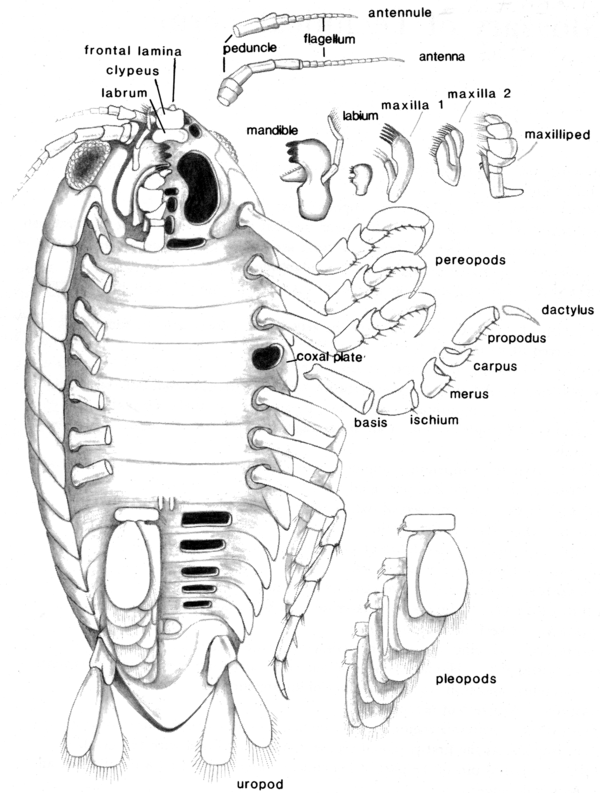- flagellum
- A long, multi-segmented sensory appendage found at the distal ends of the antennae [Mauchline, 1984].Antennal endopodite; thin, tapering, multiarticulate, elongate extension of antenna and antennule (distal to peduncle) [Hobbs and Jass, 1988].Multiarticulate appendage of antennule (2 present) and antenna (1 only); also appendage of exopods of maxillipeds. (Pl. flagella) [Poore, 2004].Multiarticulate distal portion of antennule, antenna, or exopod. (Pl. flagella) [McLaughlin, 1980].Multiarticulate, usually whiplike terminal part of the antennule or antenna (Fig. 3B). (Pl. flagella) [Perez Farfante and Kensley, 1997].Slender, multiarticulate distal part of antennule, antenna or exopod [Moore and McCormick, 1969].The distal, multiarticulate endite attached to the antennal and antennular peduncle and exopods of the maxillipeds [Ingle, 1983].The long, tapering distal part of either the antennula or antenna, generally made of many annuli [Wilson, 1989].The multiarticulate, typically filamentous part of an antennule or antenna [Hobbs, Hobbs, and Daniel 1977].The multiarticulate, usually whiplike terminal portion of an antennule or antenna. (Pl. flagella) [Chace and Hobbs, 1969].The multiarticulate, usually whiplike terminal portion of antenule or antenna. (Pl. flagella) [Butler, T.H.].The often long and multi-articled region distal to the peduncle of the antennule and antennae, and the basis of the uropod [Holdich and Jones, 1983].(Order Diplostraca):One of two multisegmented branches of antenna; each of the up to 25 segments (articles) bears a row of spine-like setae anteriorly and brush-like setae posteriorly. Number of segments is of taxonomic importance [Stachowitsch, 1992].(Class Cephalocarida):Aesthetasc [Stachowitsch, 1992].(Order Cumacea):Distal division of antennule of antenna (peduncle, flagellum). In antennule, one may distinguish a larger outer (main) and smaller inner (accessory) flagellum. Flagellum of antennule bears aesthetascs. (multiarticulate, uniarticulate) [Stachowitsch, 1992].(Order Tanaidacea):Distal division of antennule or antenna (peduncle, flagellum). Antennule may bear two flagella (with distal segments bearing aesthetascs) [Stachowitsch, 1992].(Order Decapoda):Distal of two divisions (peduncle, flagellum) of antennule or antenna; typically paired in the former, unpaired in the latter. Slender, consisting of numerous segments (articles). May also refer to branch of mouthpart. (straight, bent; filiform, fusiform, platelike; cross section: circular, dorsoventrally flattened, U-shaped; hairy, smooth, spinose) [Stachowitsch, 1992].(Order Amphipoda):Distal division of antennule or antenna (peduncle, flagellum). May bear sensory structures (aesthetascs on antennules, calceoli on antennules and antennae). If two flagella are present on antennule, one distinguishes a larger (primary) and smaller (accessory) flagellum [Stachowitsch, 1992].(Order Isopoda):Distal division of antennule or antenna (peduncle, flagellum); composed of a varying number of articles [Stachowitsch, 1992].(Order Isopoda):Distal part of antenna or antennule, usually multiarticulate, occasionally reduced to one or a few articles [Kensley and Schotte, 1989].(
 )Schematic representation of an isopod illustrating morphological terms. [Kensley and Schotte, 1989](Order Isopoda):Narrow distal part of antenna or antennule, usually multiarticulate, occasionally reduced to one or a few articles, without intrinsic musculature [Wetzer et al. 1997].(Order Mysida):In antennule, pair of elongate branches of peduncle. In antenna, elongate inner branch of peduncle consisting of three- to four-segmented basal section and multisegmented distal section. Also refers to annulate distal part of outer branch (exopod) or thoracopod [Stachowitsch, 1992].(Order Stomatopoda):Distal section of antennule or antenna (peduncle, flagellum); slender, consisting of numerous segments (articles). Antennule bears three flagella (one dorsal and divided ventral flagella); antenna, one flagellum (on endopod) [Stachowitsch, 1992].(Order Leptostraca):Distal division (peduncle, flagellum) of antennule. Represents inner branch (endopod). May also refer to endopod of antennule. (long with many small articles, small with few large articles) [Stachowitsch, 1992].(Subclass Branchiura):Palp [Stachowitsch, 1992].(Subclass Copepoda):Multiarticulate distal section of antennule [Stachowitsch, 1992].(Class Remipedia):Distal section of antennule. One may distinguish a longer dorsal flagellum composed of 11 or 12 segments (articles) and a shorter ventral flagellum composed of 8 articles (in one case fused into a blade-like structure). Each article bears several setae [Stachowitsch, 1992].(Superorder Syncarida):Distal division of antennule or antenna (peduncle, flagellum). (paired, unpaired) (see also scaphocerite) [Stachowitsch, 1992].(Order Thermosbaenacea):Distal division of antennule or antenna (peduncle, flagellum), paired in the former, unpaired in the latter. (See also aesthetasc) [Stachowitsch, 1992].(Order Euphausiacea):Elongate, multiarticulate distal end of antennule or antenna. Paired in the former, unpaired and representing inner branch (endopod) in the latter [Stachowitsch, 1992].
)Schematic representation of an isopod illustrating morphological terms. [Kensley and Schotte, 1989](Order Isopoda):Narrow distal part of antenna or antennule, usually multiarticulate, occasionally reduced to one or a few articles, without intrinsic musculature [Wetzer et al. 1997].(Order Mysida):In antennule, pair of elongate branches of peduncle. In antenna, elongate inner branch of peduncle consisting of three- to four-segmented basal section and multisegmented distal section. Also refers to annulate distal part of outer branch (exopod) or thoracopod [Stachowitsch, 1992].(Order Stomatopoda):Distal section of antennule or antenna (peduncle, flagellum); slender, consisting of numerous segments (articles). Antennule bears three flagella (one dorsal and divided ventral flagella); antenna, one flagellum (on endopod) [Stachowitsch, 1992].(Order Leptostraca):Distal division (peduncle, flagellum) of antennule. Represents inner branch (endopod). May also refer to endopod of antennule. (long with many small articles, small with few large articles) [Stachowitsch, 1992].(Subclass Branchiura):Palp [Stachowitsch, 1992].(Subclass Copepoda):Multiarticulate distal section of antennule [Stachowitsch, 1992].(Class Remipedia):Distal section of antennule. One may distinguish a longer dorsal flagellum composed of 11 or 12 segments (articles) and a shorter ventral flagellum composed of 8 articles (in one case fused into a blade-like structure). Each article bears several setae [Stachowitsch, 1992].(Superorder Syncarida):Distal division of antennule or antenna (peduncle, flagellum). (paired, unpaired) (see also scaphocerite) [Stachowitsch, 1992].(Order Thermosbaenacea):Distal division of antennule or antenna (peduncle, flagellum), paired in the former, unpaired in the latter. (See also aesthetasc) [Stachowitsch, 1992].(Order Euphausiacea):Elongate, multiarticulate distal end of antennule or antenna. Paired in the former, unpaired and representing inner branch (endopod) in the latter [Stachowitsch, 1992].
Crustacea glossary. Natural History Museum of Los Angeles County. 2011.
